- Vaccine optimism wanes
- Rising coronavirus cases and fears of additional lockdowns in US states dampen positive sentiment
- Bitcoin reaches 3-year high
- Brexit talks look set to continue as the U.K. and EU approach the latest deadline.
- In the US existing home sales will be published on Thursday.
- The Bank of Indonesia makes its rate decision on Thursday.
- On Friday UK and Canadian retail sales are due to be released.
- Futures on the S&P 500 Index were down 0.2%.
- The Stoxx Europe 600 Index was little changed.
- The MSCI Asia Pacific Index rose 0.2%.
- The MSCI Emerging Market Index climbed 0.6%.
- The Dollar Index declined 0.2% to $92.26.
- The euro increased 0.1% to $1.1879.
- The British pound climbed 0.3% to $1.3283.
- The Japanese yen strengthened 0.2% to 103.97 per dollar.
- The yield on 10-year Treasuries decreased one basis point to 0.85%.
- The yield on two-year Treasuries gained less than one basis point to 0.17%.
- Germany’s 10-year yield fell less than one basis point to -0.57%.
- Britain’s 10-year yield dipped less than one basis point to 0.323%.
- West Texas Intermediate crude gained 0.7% to $41.67 a barrel.
- Gold strengthened 0.1% to $1,883.10 an ounce.
Key Events
US futures, including for the Dow, S&P, NASDAQ and Russell 2000 and European shares were all marginally higher on Wednesday as investors attempt to balance positive news on a potential vaccine against increasing COVID-19 cases worldwide.
The dollar and gold continue to fall, while oil has been trading higher.
Global Financial Affairs
Ahead of the trading week, we predicted that the market would be driven by two conflicting forces around the same theme: the vaccine and the virus
And for the second day the exodus out of sectors that thrive in the stay-at-home environment to stocks that perform well in an economic recovery reversed. As coronavirus cases continue to escalate across the US, traders have been concerned that until any potential vaccine is approved and widely distributed, the economy cannot restart in a meaningful way. So they quickly jumped back into in technology stocks.
The recent rally that propelled global stocks to records—with US indices including the Dow and S&P 500 leading—was ignited by vaccine progress, as investors began to imagine the return to a normal world without social restrictions. As a result, industries that benefited from the virus, such as technology companies that enabled people to stay connected for employment, shopping and entertainment, were suddenly viewed as too pricey. Investors cashed out and invested those profits into the new bargains—traditional value stocks.
In Europe, the Stoxx 600 index fell at the open this morning, but managed to rebound and is little changed as of the time of writing, as France became the first European country to exceed 2 million COVID cases. The technology sector rally offset losses in energy and real estate shares.
Asian benchmarks were less one-sided. Australia’s ASX 200 and South Korea’s KOSPI both advanced 0.5%. Japan’s Nikkei 225, was, the outlier. It fell 1.1%, pressured by automobile stocks, one of the country’s major exports, overshadowing better-than-expected total exports. The market there was also dented by the news that coronavirus cases in Tokyo had started to increase again.
American stocks retreated from records on Tuesday, as investors sold off sectors sensitive to the economy after the release of weak US consumer data.
Pharmacy chains underperformed on the S&P 500 after Amazon (NASDAQ:AMZN) announced the company’s incursion into prescription drug sales. Tesla (NASDAQ:TSLA) has added over 9% after news of its inclusion on the S&P 500 Index beginning Dec. 21 was announced on Monday, helping the maverick company, considered by some critics to be unstable, is set to gain blue chip status.
The VIX pushed against Monday's lows.

If the “fear gauge” declines by another 0.2% it will hit the lowest level since Aug. 25—quantifying the jitters the virus will have on market volatility.
Like the volatility index, yields also seemed to find support, for now. While yields are down for the second day—after Chairman of the Federal Reserve, Jerome Powell warned the country’s economy has a “long way to go” before returning to pre-pandemic levels.
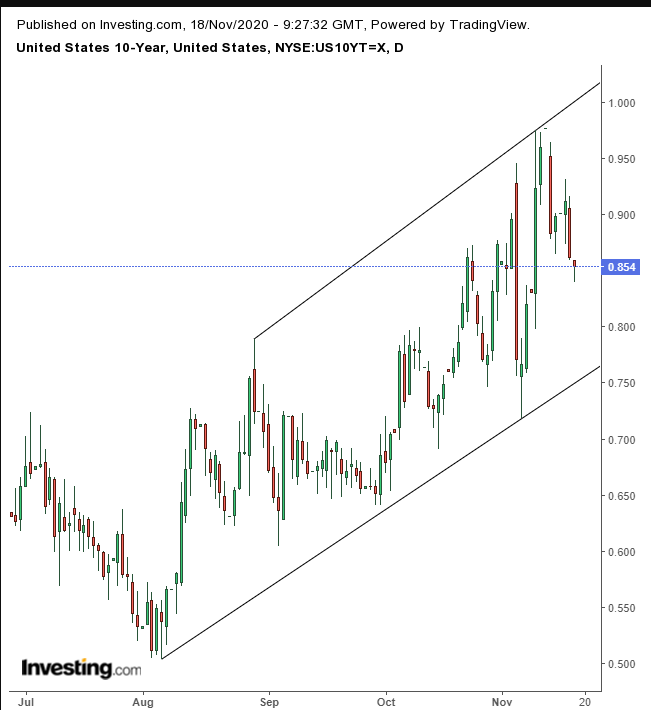
Yields, including for the 10-year Treasury note, did rebound off their lows, demonstrating hoarding of Treasuries. The overall trend is clearly rising, framed within the clearly defined rising channel.
The dollar was dragged lower, extending the decline to its fifth straight day—its longest losing streak since Aug. 18, three months to the day.
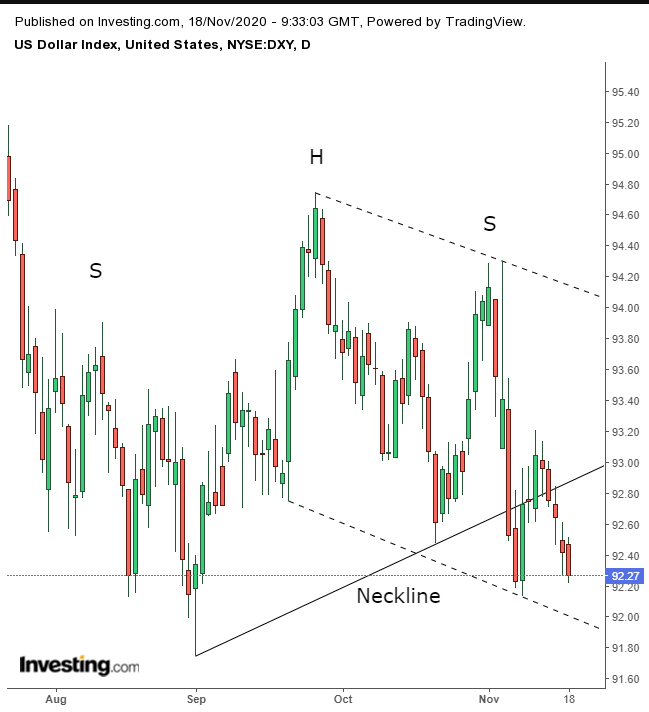
The USD’s test will be the Nov. 9 low and the bottom of the falling channel.
Gold fell for the second day, which is noteworthy considering that both the dollar and stocks are also in decline.
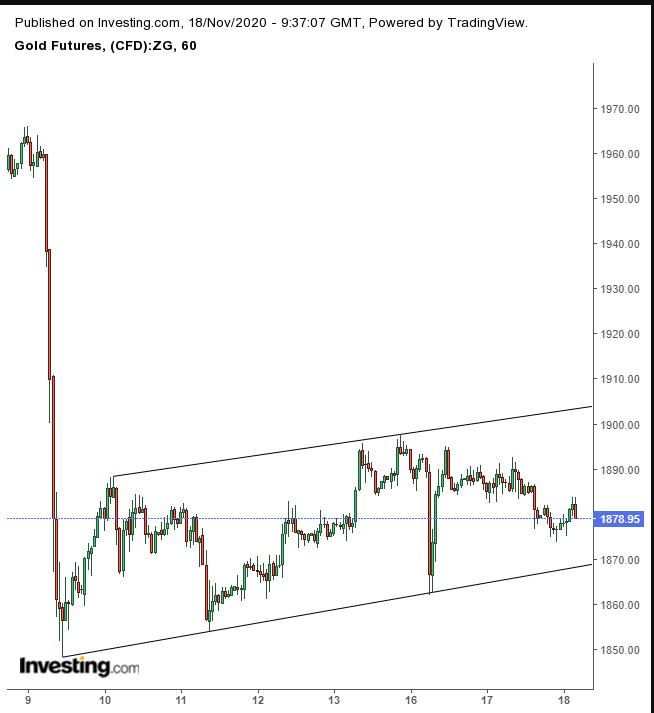
Gold has been rising in the short-term within a shallow rising channel, slowly picking up the pieces since the preceding 5.5% crash.
Bitcoin gained for the third day in a row, for the first time in almost two weeks. The popular cryptocurrency hit its highest level in three years on Tuesday after crossing the $17,000 mark, as Ray Dalio, co-founder of Bridgewater Associates, the world’s largest investment fund, tweeted: “I might be missing something about Bitcoin."
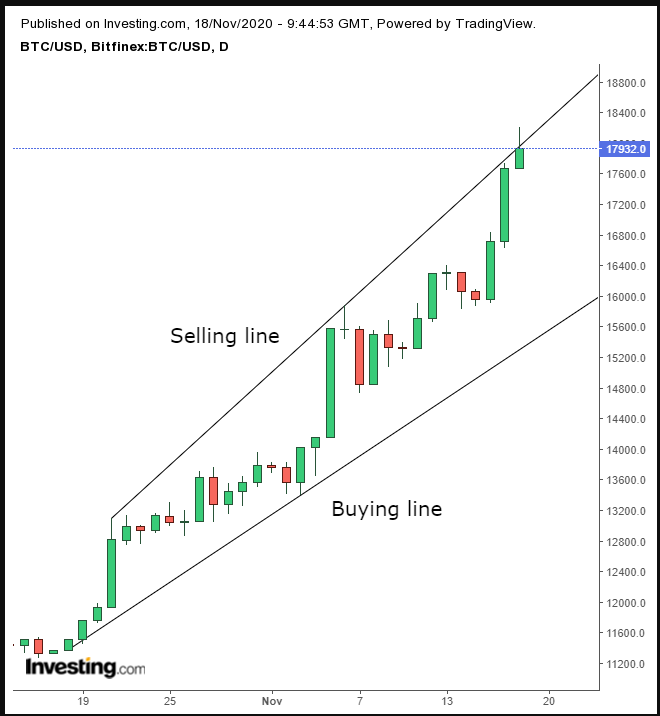
However, the price found resistance at the $18,000 level, pushing the digital asset off its highs, potentially forming a shooting star. Bitcoin was pushed down below its rising channel, which is continuously being stretched. We’d feel more comfortable buying it at the $16,000 level, upon a return to the channel’s buying line as noted on the chart.
Oil struggled to cross over the $42 threshold as investors weigh a stockpile build of over 4 million barrels versus Asia demand.
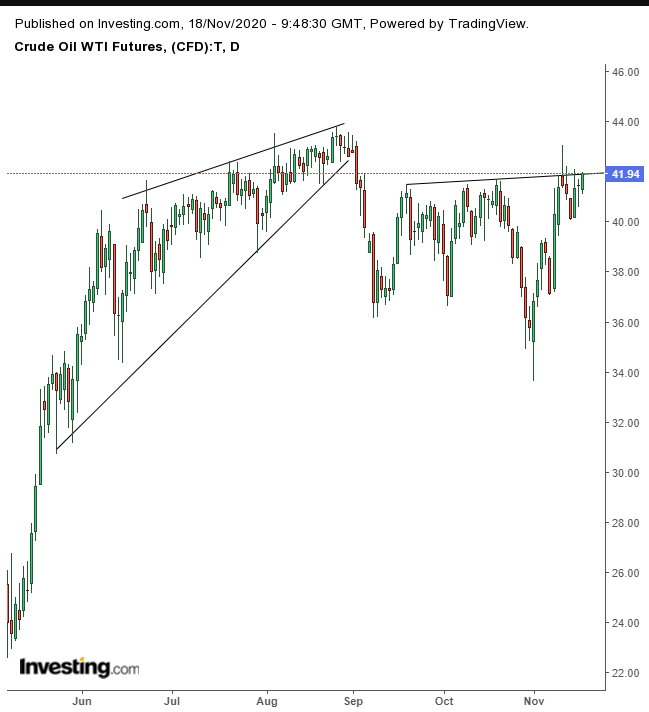
If the oil price climbs over $42 It may complete a bottom, but money is on retesting the $36 range low after the bearish wedge.
